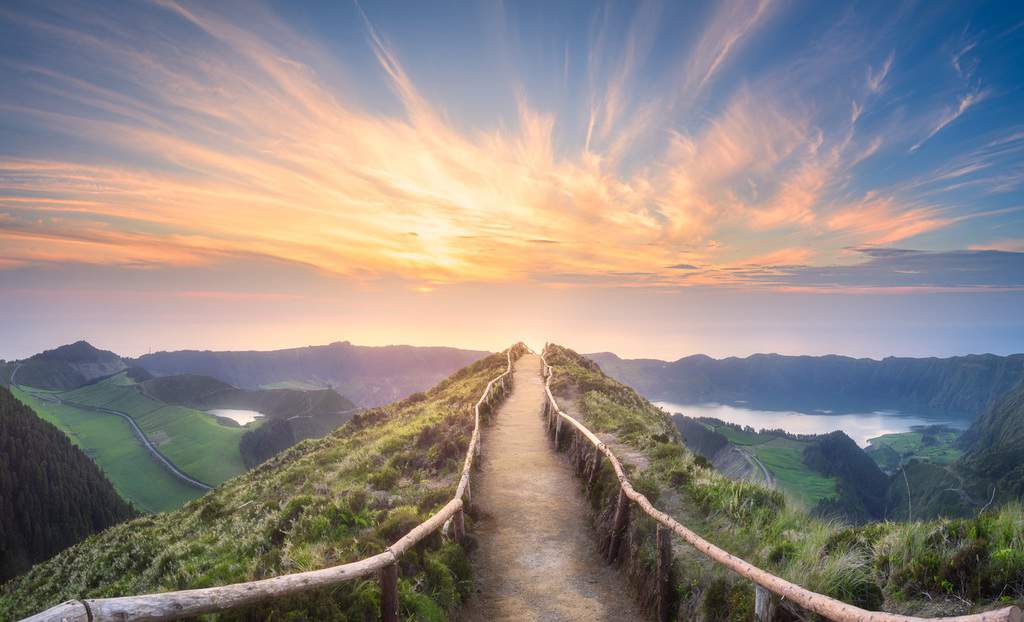Top Azores Wineries & Wine Tasting Experiences
The Azores are just as exotic and beautiful as they sound. This Portuguese archipelago consists of nine islands dotting mid-Atlantic Ocean. Far-flung and verdant, the volcanic Azores have a certain isolated, remote charm — and a forgotten wine scene that deserves recognition.
- Top Azores Wineries & Wine Tasting Experiences
- Wineries & Wine Tasting Experiences on the Azores
- The Wine Islands (and their Grapes)
- The Azores Wine History
- How To Reach The Azores
- Frequently Asked Questions about Azores Wine, Wineries & Vineyards
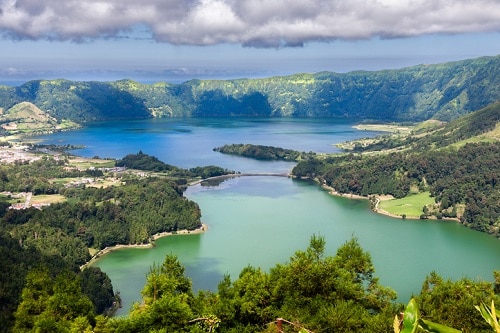
Wineries & Wine Tasting Experiences on the Azores
Pico
You’ll have the most wine-tasting opportunities on the island of Pico. First off, you can simply admire the unique wine landscape of the Paisagem da Cultura da Vinha da Ilha do Pico by driving around the island to see these special plots and stones. Don’t forget to check out Pico, the highest mountain peak in Portugal which inspired the island’s name. Below, find a range of wineries on Pico in the Azores.
Azores Wine Company
Rua do Vale da Murta, 15, 9700-531 Praia da Vitória, Portugal
Nestled within the tranquil town of Bandeiras, on the picturesque island of Pico, the Azores Wine Company stands as a testament to family dreams, hard work, and an enduring love for viticulture. This enchanting family-owned winery, established in the balmy summer of 1990 by António and Maria do Céu Ferreiros, has grown from its humble beginnings into a distinguished name within the wine industry. Steeped in tradition yet embracing modern viticulture techniques, their winemaking process is a harmonious marriage of old and new, yielding a diverse array of award-winning wines that captivate both novice and seasoned wine enthusiasts alike.
From robust reds that carry the tantalizing hint of the island’s volcanic soil, to delicate whites echoing the freshness of the Atlantic breeze, and effervescent sparkling wines that dance on the palate, each bottle from the Azores Wine Company tells a unique story. Visitors to this remarkable winery can embark on an immersive journey into the world of wine, with tours and tastings that reveal the nuances of their craft and the passion behind each vintage. And the experience doesn’t stop there; the on-site restaurant serves a captivating blend of local cuisine and international dishes, each carefully crafted to complement their wines, offering visitors a delightful foray into the island’s gastronomic scene.
Cooperativa Vitivinicola Da Ilha Do Pico (CVIP)
Rua do Adro, 11, 9700-613 Biscoitos, Portugal
Rooted in the heart of Madalena on the island of Pico, Picowines, C.R.L. is more than just a cooperative winery. It’s a communal labor of love, built in 1957 by a dedicated band of local farmers. Their collective vision and shared passion for their craft have transformed Picowines into an esteemed name within the wine industry, whose bottles have claimed awards and captured hearts, far and wide.
The winery’s production is as diverse as it is exceptional. From their bold reds that carry the rich undertones of Pico’s unique soil, to the refreshing whites that offer a taste of the cool Atlantic winds, and the lively sparklings that promise a burst of celebration with each sip. But Picowines’ distinct appeal isn’t limited to the variety of their wine. It extends to the immersive experiences they offer.
Visitors are welcome to step into the everyday workings of the winery through tours and tastings. These sessions provide a unique opportunity to understand the winemaking process and appreciate the hard work and dedication that goes into every bottle. Adding to the charm is a quaint shop on the premises. Here, guests can browse through a selection of their favorite wines, taking a piece of the Picowines experience back home.
RELATED: Best Douro Valley Wine Tours, Wine Tastings & Vineyard Resorts: Travel Guide 2023
Paisagem da Cultura da Vinha da Ilha do Pico
As we mentioned before, a drive through this is a UNESCO World Heritage Site is well worth it while visiting the island of Pico. The site consists of a series of vineyards that were planted on the slopes of Mount Pico in the 16th century. The vineyards are unique in their use of volcanic soil and terracing techniques. The wines produced from the grapes grown in these vineyards are some of the most sought-after in the Azores.
Adega Vitivinícola Lucas Lopes Amaral
Canada das Adegas, 11 – Campo Raso, 9950-105 Candelária, Portugal
At the heart of Pico Island, within the spellbinding Azores archipelago, you’ll find a hidden gem called Adega Vitivinícola Lucas Lopes Amaral. This family-owned winery, passed down through generations, isn’t just another stop on a wine connoisseur’s itinerary. It’s a journey into the captivating realm of Portuguese viticulture, where the love for wine and land intertwines seamlessly with the serenity of the sea and the majesty of the towering Pico Mountain.
The winery is renowned for its selection of white wines, produced from a diverse range of locally grown grapes like Verdelho, Arinto, and Terrantez. With every sip, you can taste the essence of the island’s volcanic soil, infused with the freshness of the Atlantic breeze. Each bottle encapsulates the island’s unique terroir, the winemaker’s meticulous craftsmanship, and a timeless legacy that makes every glass an immersive experience.
And what could be a better setting to enjoy these wines than the winery’s stunning terrace? Here, as the sun dips below the horizon, the spectacle of nature unfolds. The seascape bathed in the golden hues of the sunset forms a striking contrast with the verdant Pico Mountain, creating a picture-perfect backdrop that elevates your wine-tasting experience.
But it’s not just the wines and views that leave an indelible mark on the visitors. It’s the heartwarming hospitality of the family that runs the winery. Sandra, mother of the winemaker and your gracious host, weaves enchanting stories of their wines, the family’s history, and the Azores, imparting a sense of belonging that lingers long after you leave. The family’s passion for their work and love for their island home is palpable, making you feel more like a friend than a visitor.
The winery also offers an assortment of local cheeses, drizzled with local honey, that perfectly complements their wines. Each bite, like each sip, offers a taste of Pico’s rich culture and natural bounty, an experience that shouldn’t be missed.
Adega Czar
Zona Industrial de S. Roque, 9940-210 São Roque do Pico, Portugal
Adega Czar, a quaint, family-run winery nestled in the town of São Roque do Pico, is a shining example of the island’s rich wine heritage. Established in 2005 by João and Sofia Bettencourt, this winery may be small in size but is big on creating unique, small-batch wines that effortlessly capture the essence of Pico.
These boutique wines, crafted with meticulous attention to detail, have quickly earned Adega Czar recognition within the wine community. Each bottle from this charming winery is a testament to the passion, dedication, and personal touch that João and Sofia bring to their craft, making a visit to Adega Czar a truly memorable experience.
Adega “A Buraca”
Estrada Regional 1, 35 Santo António, 9940-232, Portugal
Tucked away in the picturesque town of Madalena on Pico Island, you’ll find the family-owned winery, Adega “A Buraca”. This charming establishment, founded in 1990 by António and Maria do Céu Ferreiros, has made a mark in the wine world with its award-winning creations.
From robust reds and refreshing whites to delightful sparkling wines, Adega “A Buraca” offers a rich tapestry of flavors, each echoing the unique terroir of Pico. Alongside their exquisite wines, the winery also invites visitors for tours and tastings, offering an intimate peek into the winemaking process. A quaint shop on the premises adds to the charm, allowing guests to take home a bottle or two of their favorite wines, encapsulating the Adega “A Buraca” experience in a tangible memory.
Insula Atlantis – Enoturismo
Perched in the charming town of Madalena, on the captivating island of Pico, is a haven for wine lovers and travellers alike – Insula Atlantis – Enoturismo. This hotel is not your typical holiday accommodation; it’s a unique and immersive journey into the world of wine, where the comforts of a modern stay blend seamlessly with the allure of a thriving winery.
Insula Atlantis boasts its own vineyard, where grapes are cultivated with care, harvested, and transformed into a diverse range of exquisite wines. Guests are invited to partake in insightful tours and tastings, an opportunity to witness the winemaking process firsthand, from the vine to the bottle. Each tour unfolds the magic behind the vineyard’s array of wines, allowing guests to appreciate the nuances and subtleties that make each vintage unique.
Adding to the enriching experience is the hotel’s on-site restaurant. Here, culinary delights meet vinicultural excellence, offering a gastronomic adventure that delights the palate. The menu is a showcase of local and international cuisine, thoughtfully paired with wines from the property’s own winery. Each dish is not just a meal but an experience, harmonizing flavors in a dance of taste and aroma that perfectly complements the wines.
Check Prices at Insula Atlanis on TripAdvisor
Adega de Santana
Rua de Cima de Sant’ana, 9940-213 São Roque do Pico, Portugal
In the charming town of São Roque do Pico, amidst the breathtaking landscapes of the island, resides Adega de Santana – a go-to destination for all things catering. This isn’t your typical food and drink supplier. Adega de Santana has carved a niche for itself by providing an exceptional selection of wines and alcoholic beverages for events, big or small. Whether it’s a wedding reception, a corporate gathering, or an intimate dinner party, they ensure each event is elevated by their carefully curated selection of beverages.
But Adega de Santana is more than just a supplier. They’re aficionados who take pride in their collection and are eager to share their passion for wines. They extend an open invitation to all wine enthusiasts to visit their facilities for an immersive experience. Here, visitors can delve into the intricate world of winemaking, tour their vast cellars, and partake in tastings that spotlight their exceptional range. It’s a behind-the-scenes access that gives a deeper appreciation for the beverages they supply, making Adega de Santana not just a provider, but a partner in crafting memorable events.
São Miguel Wineries & Tours
Quinta Da Jardinete
M511-1 19, Fenais da Luz, Portugal
In the idyllic town of Fenais da Luz on the vibrant island of São Miguel, Quinta Da Jardinete stands as a beacon of familial passion and tradition. This family-owned winery, established in 1990 by António and Maria do Céu Ferreiros, serves as a testament to the couple’s commitment to the art and science of winemaking. It’s not just the vineyard’s scenic location that sets it apart, but also its remarkable collection of award-winning wines.
The breadth and depth of Quinta Da Jardinete’s offerings are noteworthy. From the intensity of their full-bodied reds, the crispness of their whites, to the bubbly delight of their sparkling wines, each variety offers a unique tasting experience, capturing the heart of São Miguel’s terroir in every bottle. But the Quinta Da Jardinete experience extends beyond the taste of their exceptional wines.
The winery invites visitors to take part in tours and tastings, unveiling the behind-the-scenes of their winemaking process. It’s an educational journey that amplifies the appreciation of their wines, allowing Winetravelers to understand the meticulous craft that goes into every bottle. To round off the visit, guests can stop by the winery’s quaint on-site shop, offering a range of their fine wines, giving visitors a chance to take a piece of Quinta Da Jardinete home. This comprehensive experience combines the beauty of the location, the richness of the wines, and the warmth of the Ferreiros family, making a visit to Quinta Da Jardinete an unforgettable journey.
São Miguel Wine & Food Evening Walking Tour in Ponta Delgada
Immerse yourself in the vibrant culinary landscape of Ponta Delgada on this comprehensive tasting tour offered by By Hungry Whales Cultural and Food Tours . As you traverse the beautiful capital of the Azores with a small group, you’ll encounter authentic local delicacies and learn about the rich cultural tapestry that shapes this archipelago.
This tour is an adventure for your palate, offering you an array of 100% Azorean products. Discover the depth and variety of Azorean wines, from the robust reds and crisp whites to the unique ‘bastardo’ and fortified varieties. Complementing these wine tastings are six pairings of Azorean tapas, introducing you to an assortment of seafood, meat, cheese, charcuterie, and indulgent pastries. Liqueurs and a surprise beverage add an exciting twist to the experience. Mineral and bottled water are also provided for your comfort.
This tour offers an unparalleled opportunity to appreciate the history and gastronomy of the Azores, making it a must-do experience when visiting São Miguel. The same company also offers an exceptional tour that focuses on pairing over 40 local cheeses with the island’s wines.
Graciosa
Adega E cooperativa Agricola Da Ilha Graciosa
Charco da Cruz, n12, 9880-308 Santa Cruz da Graciosa, Portugal
The Museum of Graciosa also sheds some light on the history of winemaking in the Azores. A visit to the Terra do Conde winery will allow you to taste local wine paired with Portuguese pastries.
Biscoitos Region on Terceira
Adega Dos Ferreiros
Rua do Vale da Murta, 15, 9700-531 Praia da Vitória, Portugal
Adega Dos Ferreiros is a family-owned winery located in Praia da Vitória, Portugal. The winery was founded in 1995 by António and Maria do Céu Ferreiros, and it is known for its award-winning wines. The winery produces a variety of wines, including reds, whites, and sparkling wines. The winery also offers tours and tastings, and it has a restaurant on-site.
Adega Quinta da Falência
Rua da Falência, 10, 9700-531 Praia da Vitória, Portugal
In the picturesque locale of Praia da Vitória, Portugal, lies a hidden gem that wine enthusiasts cherish – Adega Quinta da Falência. Founded in 2005 by the visionary duo, João and Sofia Bettencourt, this small family-owned winery is a testament to dedication and a shared love for wine. Adega Quinta da Falência has quickly made a name for itself with its delectable small-batch wines, striking a perfect balance between tradition and innovation.
The diversity of their offerings is quite remarkable, catering to an array of palates. From the deep, earthy notes of their reds to the light, refreshing undertones of their whites, and the celebratory fizz of their sparkling wines, each bottle encapsulates the unique terroir of Praia da Vitória.
Adega Cooperativa Dos Biscoitos, Crl
Canada Do Caldeiro, Biscoitos, Biscoitos, Angra Do Heroísmo, Portugal
Adega Cooperativa Dos Biscoitos, Crl is a cooperative winery located in Biscoitos, Portugal. The winery was founded in 1957 by a group of local farmers, and it is known for its award-winning wines. The winery produces a variety of wines, including reds, whites, and sparkling wines. The winery also offers tours and tastings, and it has a small shop on-site.
Museu do Vinho (Biscoitos)
Canada do Caldeiro 3, 9760-054 Biscoitos, Portugal
The Biscoitos Wine Museum is a museum located in Biscoitos, Portugal. The museum was founded in 2007, and it is dedicated to the history of winemaking in the Azores. The museum has a collection of artifacts, including wine presses, barrels, and bottles. The museum also offers tours and tastings.
The Wine Islands (and their Grapes)
Azores wine comes from three main islands. The island of Pico cultivates most of the wine, and the rest comes from Graciosa and the Biscoitos region of Terceira.
The Azores boasts over 30 grape varieties. The grapes make both red and wine wine, but a few varieties are more common than others.
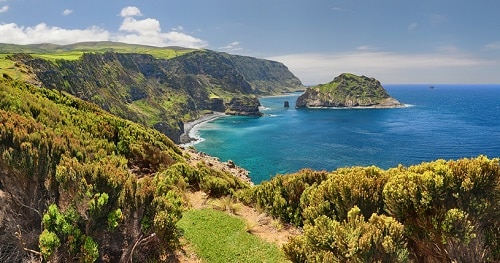
The Pico region has the most wine production and uses grape varieties like Verdelho (although this is one of the most famous grapes on the island, it’s actually from Cyprus and Sicily and not native to the Azores), Arinto and Terrantez. Graciosa usually produces wine from grapes such as Arinto, Boal, Terrantez and Fernão Pires. The Biscoitos region on Terceira usually makes fortified wine using Verdelho, Arinto and Terrantez.
In general, Arinto grapes, as well as Terrantez and Verdelho, typically produce white wine while Syrah and Merlot are used to produce red wines.
The Azores Wine History
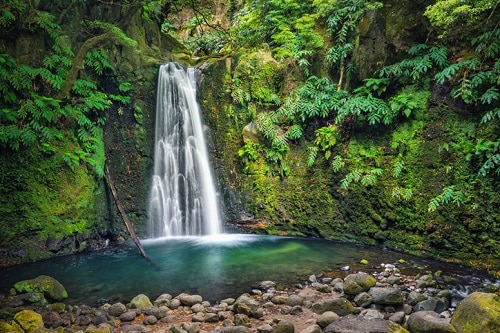
Although wine conditions are rather extreme, with vines planted close to the sea in volcanic, salty soil, the islands still produce some excellent wines. And wine production isn’t new to the Azores. The islands have been cultivating the drink for hundreds of years.
RELATED: Discover More Unique Wine Regions on the Free Winetraveler App
One of the solutions to protect the wine from the elements is basalt stone walls separating small plots of wines called currais. The crumbling stone walls aren’t new, though, they were built at least 500 years back and are now recognized by UNESCO as a World Heritage Site. These walls create a kind of microclimate for the grapes, protecting them from salt, wind and other atmospheric elements.
Smaller rocks and stones litter the plots too. These lava rocks absorb sunlight and reflect the heat to the vines. Winegrowers even arranged and planted vines in a specific way: from east to west.
Once the wine was ready for export, ships often couldn’t dock near the vineyards due to the rough volcanic landscape. So, winemakers tossed their barrels into the sea. Then, ship workers would ferociously fish them out of the water and carry them to mainland Europe. Today, though, locals export wine with much more care. And, production has grown immensely in past years.
How To Reach The Azores
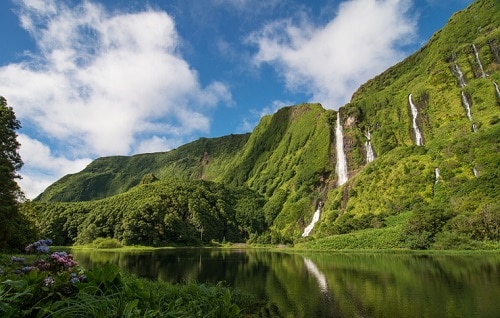
TAP Portugal and Azores Airlines both fly nonstop from Boston (BOS) to the main Azores hub, Ponta Delgada (PDL). The trip takes less than five hours. You can also fly nonstop on TAP from Lisbon (LIS) which is over two hours. Azores Airlines operates a flight from Ponta Delgada (PDL) to Terceira (TER) in 40 minutes.
Or, fly to Pico Island (PEX) in 50 minutes from (PDL). From Terceira (TER) you can fly nonstop to Graciosa (GRW) in 30 minutes on Azores Airlines. Atlantico Line ferries also operate between the islands. Find flights and get updates on deals here.
